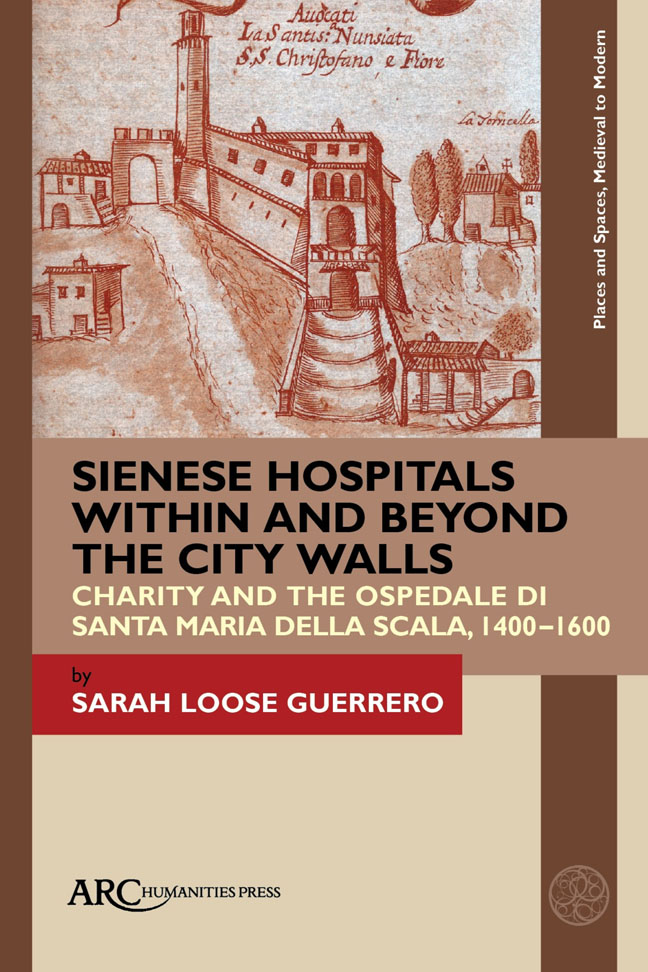 Sienese Hospitals within and beyond the City Walls
Sienese Hospitals within and beyond the City Walls Published online by Cambridge University Press: 17 February 2024
AdornIng the wAlls of the Room of the Nine in Siena's Palazzo Pubblico are Ambrogio Lorenzetti's famous frescoes, completed between 1338 and 1340, that depict the effects of good and bad government. In both scenes one identifiable theme is the relationship between the urban centre of Siena and its surrounding contado. Peace, safety, and profitable exchange between city and countryside resulted from good gov-ernment, shown in the frescoes by people with animals and goods easily entering and leaving the city gates, scenes of cultivation and harvesting, and depictions of well-main-tained homes, gardens, and fields. Meanwhile, bad government resulted in devastation and deterioration, represented in the painting by fields lying fallow, homes burning, and armed men roaming the countryside. Lorenzetti's message for Italian city-states, and Siena in particular, was that urban and rural spaces were inextricably linked.
The purpose of this chapter is to examine the link between city and countryside from the perspective of Santa Maria della Scala. Though the city was the institutional centre for the hospital, a significant part of the hospital's identity, functionality, and influence depended on its rural properties and the individuals who inhabited them. From the thirteenth to the sixteenth centuries, Santa Maria della Scala's administrators built an extensive network of farms that provided a foundation for the hospital's economic activities and served as spaces where the hospital influenced and shaped urban and rural lives. This network of rural farming properties, called grancia individually and grance in the plural, were tied to and interacted with the urban institution in myriad ways. The grance consisted of cultivated land, vineyards, orchards, and pastures, as well as homes, buildings, spaces for production, mills, and kilns. Ownership of rural lands thus wove the hospital into economic, religious, and social life beyond the walls of Siena.
In both urban and rural arenas, Santa Maria della Scala's administrators actively sought strategies that would allow the hospital to prosper and support its charitable mandate. The annual costs of distributing food and clothing for the poor, as well as providing medicine and treatment for the sick, were added to the substantial expense of caring for and raising abandoned children. From the salaries given to wet nurses to the cost of apprenticeships for boys and dowries for girls, a large portion of Santa Maria della Scala's budget went towards child care.
To save this book to your Kindle, first ensure [email protected] is added to your Approved Personal Document E-mail List under your Personal Document Settings on the Manage Your Content and Devices page of your Amazon account. Then enter the ‘name’ part of your Kindle email address below. Find out more about saving to your Kindle.
Note you can select to save to either the @free.kindle.com or @kindle.com variations. ‘@free.kindle.com’ emails are free but can only be saved to your device when it is connected to wi-fi. ‘@kindle.com’ emails can be delivered even when you are not connected to wi-fi, but note that service fees apply.
Find out more about the Kindle Personal Document Service.
To save content items to your account, please confirm that you agree to abide by our usage policies. If this is the first time you use this feature, you will be asked to authorise Cambridge Core to connect with your account. Find out more about saving content to Dropbox.
To save content items to your account, please confirm that you agree to abide by our usage policies. If this is the first time you use this feature, you will be asked to authorise Cambridge Core to connect with your account. Find out more about saving content to Google Drive.